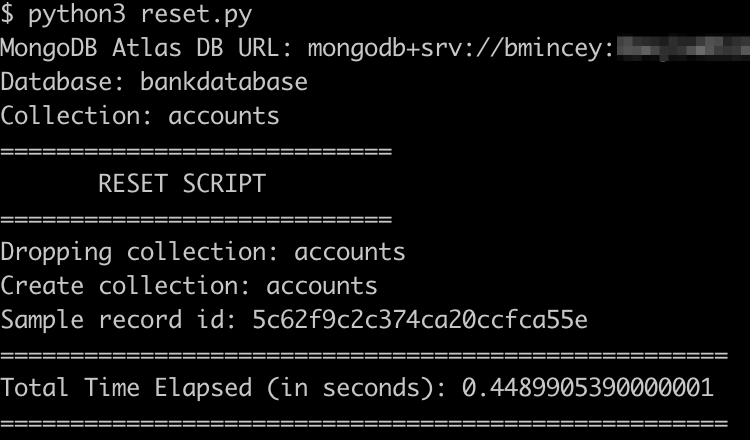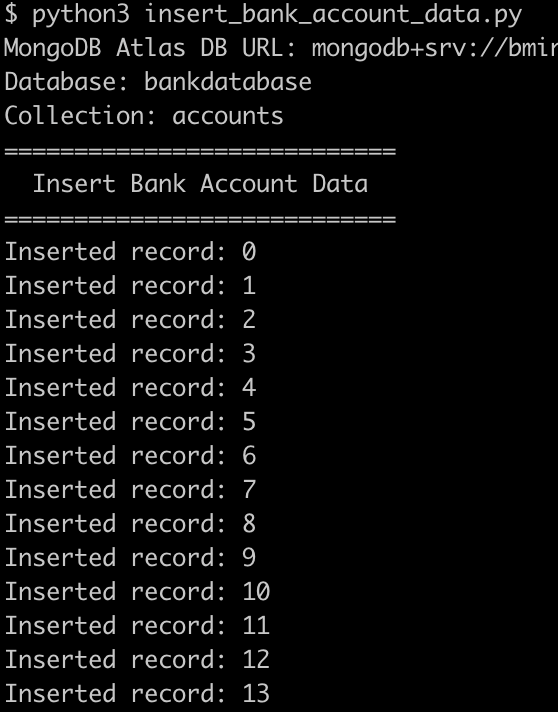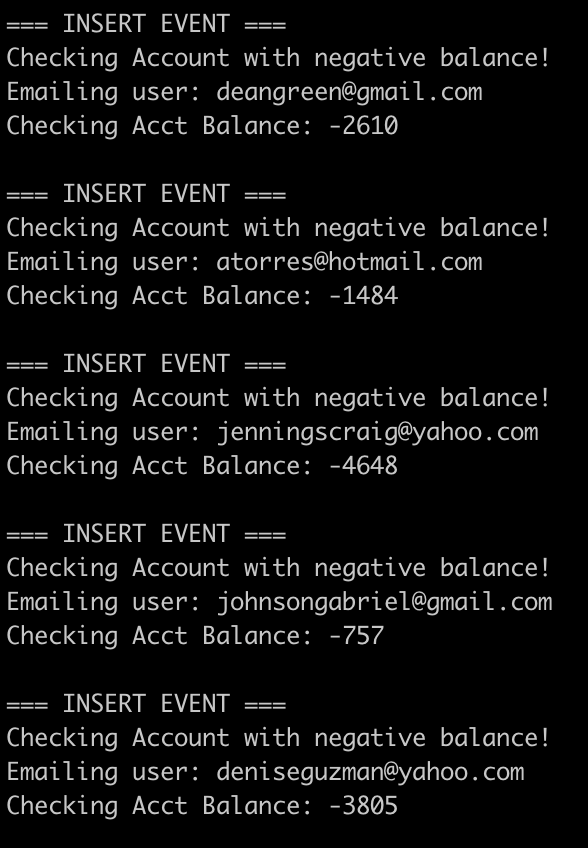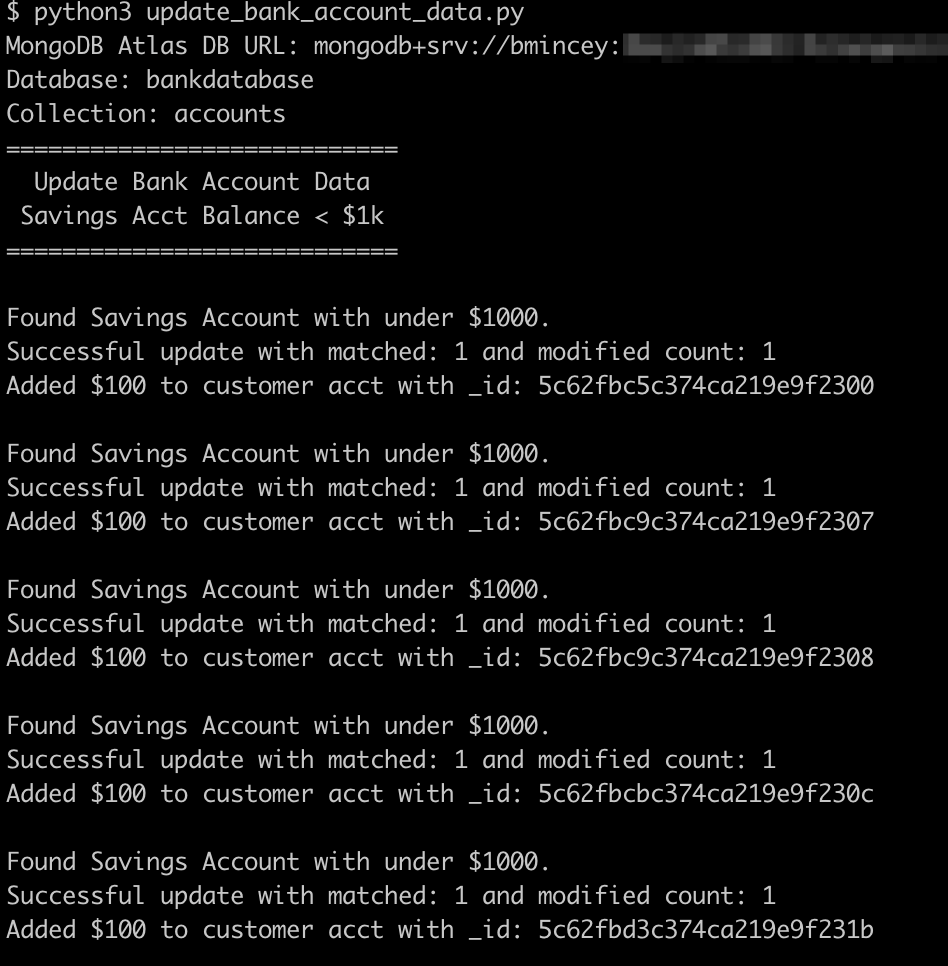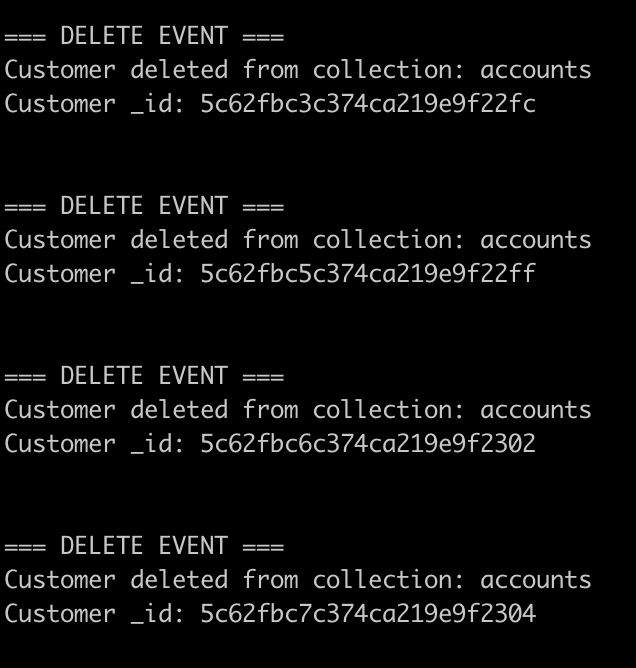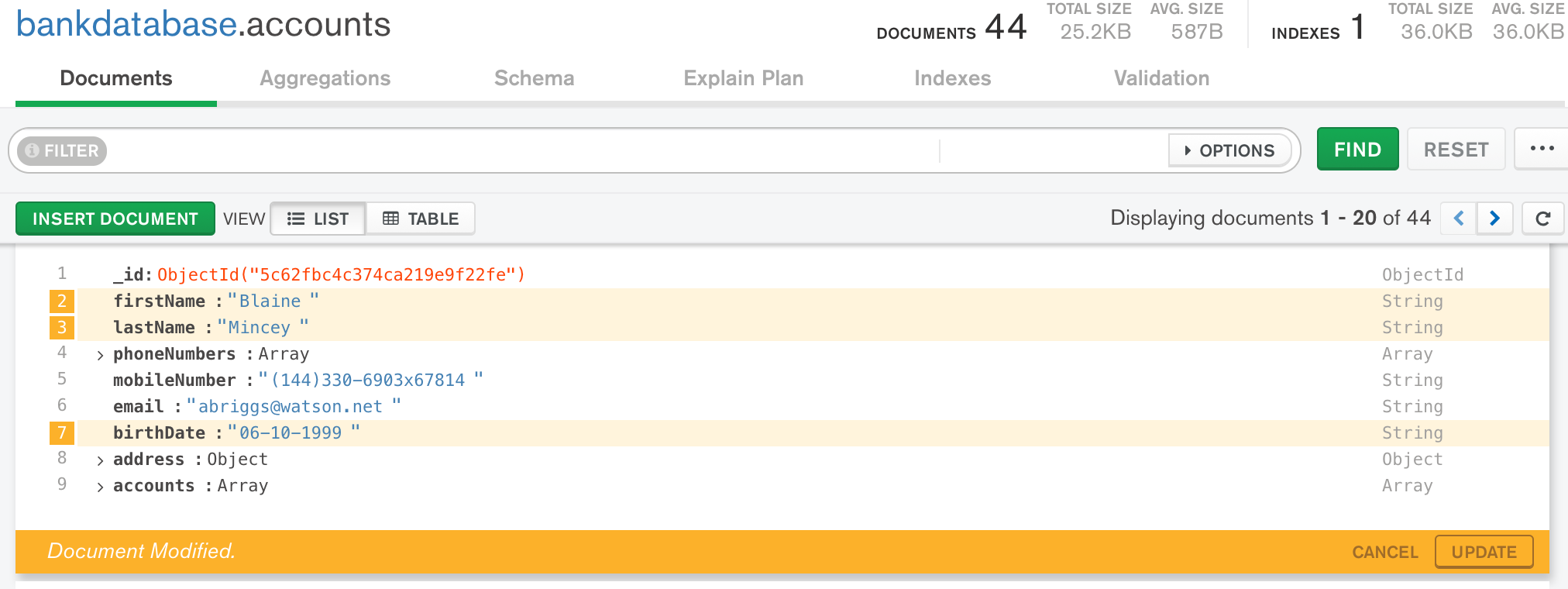Ability for applications to listen for and react to individual database events, in realtime (e.g. for fraud detection for updating a realtime visual dashboard or for CDC capture for downstream systems).
SA Maintainer: Blaine Mincey
This proof demonstrates how MongoDB can be utilized to easily implement CDC
(Change Data Capture) by using the native Change Streams capability within MongoDB.
Change Streams allow applications to access real-time data changes without the
complexity and risk of tailing the oplog. Applications can use change streams
to subscribe to all data changes on a single collection, a database, or an entire
deployment, and immediately react to them. Because change streams use the aggregation
framework, applications can also filter for specific changes or transform the notifications
at will.
In order to illustrate this capability, we will run several different Python processes to capture several distinct CRUD style operations within MongoDB. Specifically, we will run a multi-threaded Python process that will essentially listen for changes in a specific collection for Insert, Update, Delete, and Replace operations. Also, we will illustrate how a change stream can be interrupted and then resumed without missing a single change.
1. Identify an Atlas cluster
- Using a cluster you have already created in MongoDB Atlas or one that has already been created in any tier size will suffice for this proof.
2. Download/Clone the proof to a root or working directory Within your root/working directory, you should have the following:
- .env.example - Environment variable file that should be renamed to .env
- change_stream_listener.py - Multi-threaded script to listen for change events
- delete_bank_account_data.py - Script to run delete operations
- insert_bank_account_data.py - Script to run insert operations
- reset.py - Script to reset/create the database and collection
- resume_update_data.py - Script to update data and trigger a resume operation
- settings.py - Script to load environment variable from .env
- update_bank_account_data.py - Script to run update operations
- README.md - This README file
3. Configure Environment Variables
- Be sure to rename .env.example to .env
- This file contains a number of variables:
- NUM_RECORDS_TO_GENERATE - Defaults to 100 for the insert script
- DATABASE - Name of the database that is defaulted to 'bankdatabase'
- COLLECTION - Name of the collection that is defaulted to 'accounts'
- MONGODB_ATLAS_URL - The URL to your MongoDB Atlas cluster
- Copy the Application Short SRV connection string for your Atlas cluster and paste it into your .env file in the MONGODB_ATLAS_URL variable
Be sure to add your password to the URL. For example:
MONGODB_ATLAS_URL = mongodb+srv://bmincey:thePassword@changestreamcluster-r4qj4.mongodb.net/bankdatabase?retryWrites=true
4. Ensure Python3 is setup properly
- This proof was developed using Python3
- The following may need to be installed to your environment using Pip3:
- pip3 install python-dotenv
- pip3 install pymongo
- pip3 install dnspython
- pip3 install Faker
Once these modifications have been made, we can begin testing the proof.
5. Execute reset.py
This script should be run initially in order to create the database and collection as these must exist prior to starting a change stream. Upon execution, you should have this:
6. Start the primary script change_stream_listener.py
This script upon successful startup, will indicate the following:
This script should indicate that a change stream listener has started for Insert, Update, Delete, and Replace events along with the filter being used. Also, an indication of a 'resume' thread should be indicated along with its filter.
Open a separate terminal and run the insert_bank_account_data.py script. While it is running, you should see output similar to the following indicating that bank records are being inserted:
While the insert script is running, check the terminal for the change stream output which should look like the following:
The Insert event is filtered for any bank customers inserted into the accounts collection with a negative checking account balance.
Next, we will test the update change stream functionality by running the update_bank_account_data.py. As this is run, the output should look like the following:
As indicated, the script is filtering for checking accounts with under $1000 in the balance and adding $100 to it.
As the script is running, check the terminal where the change stream listener is running and the output should be similar to the following:
The Update event is being filtered for bank customers where their checking account has a deposit made and indicating the new balance.
Next, we will test the delete change stream functionality by running the delete_bank_account_data.py. As this script is executing, you should see the following in the terminal:
The delete script is deleting customers with a negative checking account balance.
As the delete script is running, check the terminal output for the change stream listener and you should find similar output to the following:
Next, we will test the replace change stream functionality by utilizing the use of MongoDB Compass. It should be noted the when an update to a document is made using MongoDB Compass, a full document replace occurs. Connect to your MongoDB Atlas Cluster using MongoDB Compass and find open the existing documents in the database we are using. If you kept the default settings, this will be the 'bankdatabase' and the 'accounts' collection. Locate a random document in the collection and make a few updates to it and then click 'Update'. This should look similar to what is here:
After you have clicked the 'Update' button, check the terminal output for our change stream listener. If you made updates to a single document, there will only be a single entry in the terminal. You should see output similar to this:
For our final execution of the proof, we will test the resume capability of change streams. This is a critical aspect of MongoDB Change Streams as it provides the capability of not losing any changes and being able to resume immediately following the last change event.
Start the resume_update_data.py script. The output should be similar to the following:
This script is filtering for customers with a checking account balance greater than $1000. For these records, an additional field named 'resumeCounter' is added to the specific document and increased by 1 so we can verify if we missed any records as we are going to terminate the change stream and then restart it.
Inspect the output of the change stream terminal, you should see something similar to the following:
It should be noted that for every 5 updates, the change stream listener will simulate a 10 second failure while the resume_update_data.py is running. After 10 seconds, the resume change stream is closed and then re-established using the resume token. Take note of the 'Counter Value' value as this is being incremented by 1. You should see, for example, in the image above, the Counter Value is 5 when a failure is indicated. Once the change stream restarts, the Counter Value starts at 6 as expected.
You can do a quick inspection using MongoDB Compass to ensure that no increments of the 'resumeCounter' field were lost during the failure simulations by doing something similar to this:
Simply filter within MongoDB Compass for documents with the 'resumeCounter' field that is greater than 0, sort by 'resumeCounter' ascending, and then project only the 'resumeCounter' field.

